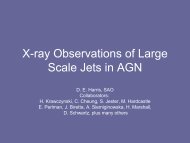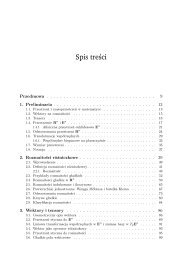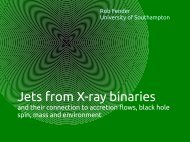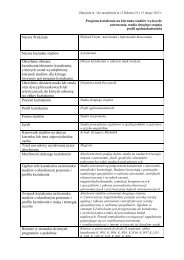Simulated synchrotron emission from Pulsar Wind Nebulae
Simulated synchrotron emission from Pulsar Wind Nebulae
Simulated synchrotron emission from Pulsar Wind Nebulae
- No tags were found...
Create successful ePaper yourself
Turn your PDF publications into a flip-book with our unique Google optimized e-Paper software.
Delia VolpiDipartimento di Astronomia e Scienza dello Spazio-Università degli Studi di Firenze-Italia<strong>Simulated</strong> <strong>synchrotron</strong><strong>emission</strong><strong>from</strong> <strong>Pulsar</strong> <strong>Wind</strong><strong>Nebulae</strong>In collaboration with:Luca Del Zanna-Dipartimento di Astronomia e Scienza dello Spazio-Università degli Studi di Firenze-ItaliaElena Amato-INAF-Osservatorio Astrofisico di Arcetri-Firenze-ItaliaNiccolò Bucciantini-Astronomy Department-University of California at Berkeley-USA
AbstractBasing on the set of MHD equations and the evolution equation of the maximum energy ofthe emitting particles (which includes adiabatic and <strong>synchrotron</strong> losses along streamlines) acomplete set of diagnostic tools aimed at producing synthetic <strong>synchrotron</strong> emissivity,polarization and spectral index maps <strong>from</strong> relativistic MHD simulation is obtained.A first application of this method is the <strong>emission</strong> <strong>from</strong> <strong>Pulsar</strong> <strong>Wind</strong> <strong>Nebulae</strong> (PWNe).The employed numerical code is described in Del Zanna & Bucciantini (2002), Del Zanna etal. (2003) and Londrillo & Del Zanna (2004).It is a shock-capturing code solving the ideal relativistic MHD and energy evolutionequations in conservative form.Axisymmetric simulations of PWNe are directly compared with the observations of theinner structure of Crab Nebula and similar objects in the optical and X-ray bands. Thetypical observed PWNe jet-torus morphology is well reproduced even in the finer <strong>emission</strong>details (arcs, rings and the bright knot) and in the velocity ranges. Spectral properties(spectral index maps and integrated spectra) are also, partially, reproduced.Further details can be found in Bucciantini et al. (2005) and Del Zanna et al. (2006).
Introduction• Optical and X-ray observations at high resolution <strong>from</strong> space (Hubble, ROSAT, Chandra,XMM-Newton) show a jet-torus structure in <strong>Pulsar</strong> <strong>Wind</strong> <strong>Nebulae</strong> (PWNe, e.g. CrabNebula and Vela).counter-jettorusknotinner ringCrab Nebula (Chandra, X-ray)jetVela (Chandra, X-ray)PWNe is a class of Supernova Remnants (SNR) called plerions. Plerions are hot bubblesemitting non-thermal radiation (<strong>synchrotron</strong> and Inverse Compton) at all wavelenghts andreceiving relativistic particles and magnetic field <strong>from</strong> the engine-pulsar. They are created byinteraction between ultra-relativistic magnetized pulsar wind (PW) and espanding SNR ejecta.
Introduction• The scheme of a plerion is (Kennel and Coroniti, 1984):Forward shock+reverse shock+contact discontinuitybetween SNR and ISM<strong>Pulsar</strong> + magnetosphereInterstellar medium (ISM)SNRForward shock+contact discontinuitybetween PWN and SNR<strong>Pulsar</strong> wind (PW)<strong>Pulsar</strong> <strong>Wind</strong> Nebula (PWN)Termination shock (TS)
Introduction•1-D RMHD theoretical models (Kennel & Coroniti, 1984-- Emmering & Chevalier, 1987)can explain torus, but not jets. 2-D theoretical ones (Bogovalov & Khangoulian, 2002 --Lyubarsky, 2002) try to interprete jet-torus morphology. The idea is: an anisotropic fluxenergy (stronger at the equator) create torus and TS oblate shape; jets are collimateddownward TS (where flux is only mildly relativistic) and appear originate <strong>from</strong> the pulsarbecause of the cusp in TS.jets(Lyubarsky, 2001)cuspTS• Only with developments of shock - capturing RMHD numerical scheme (Komissarov,1999 -- Del Zanna et al., 2003) has been possible to solve hyperbolic equations and confirmtheories about jet-torus morphology.• Initially theoretical formulas and numerical recipes (used in the code to solve the problemof the jet-torus structure) are presented. Then simulation maps are shown and discuss tounderstand dynamics and radiative <strong>emission</strong> of PWNe. At the end there will be results andfuture developments.• This work represents a complete set of diagnostic tools aimed at producing <strong>synchrotron</strong>emissivity, polarization and spectral index maps <strong>from</strong> RMHD simulations not only forPWNe, but also for the study of different classes of objects (e.g. AGN jets).
<strong>Wind</strong> magnetization
Results: flow structure maps• RunA: a) Stronger pinching forces ⇒ smaller wind zone; b) Equipartition near TS; c) Larger magnetizedregion ⇒ particles loose most of their energy nearer to TS; d) Less complex magnetization map.• Supersonic jets and equatorial outflow: v ≈ 0.5-0.7c (as in Crab Nebula-Hester-2002, Vela-Pavlov 2003).
Results: surface brightness mapsAll values are Crab Nebula ones• Optical and X emitting particles:α ν = 0.6 (Veron-Cetty & Woltjer, 1993)• Cut-off frequencies:λ=5364 Å in optical maps (V.C.,1993)hν=1keV in X maps (Chandra)• Angles (Weisskopf, 2000):inclination of symmetry axis:30 0rotation respect to North: 48 0• I ν normalized respect to maximumvalue, logarithmic scales• Larger emitting regions in optical thanin X band⇒<strong>synchrotron</strong> burn-off• Internal regions: system of rings(connected to external vortices),brighter arch (inner ring), a central knot(connected to polar cusp region) due toDoppler boosting (very strong nearTS, v≈c)• Stronger <strong>emission</strong> near TS wheremagnetization and velocity are higher• RunA is similar to Crab Nebula,(stronger <strong>synchrotron</strong> losses)• RunB is similar to Vela (lowermagnetization around equator)
Results: optical polarization maps• Synchrotron <strong>emission</strong> ⇒linear polarizationPolarization fraction• Polarization fraction isnormalized against(α ν +1)/(α ν +5/3)≈70%• Along polar axis:higher polarized fraction(projected B ⊥ line of sight)• Outer regions: depolarization(due to opposite signs ofprojected B contributionsalong line of sight)Polarization direction• Polarization ticks arebasically ortogonal to B, theirlenght is proportional topolarization fraction• Polarization angle swing(deviation of vector direction)in brighter arcs where v ≈ cand Doppler boost is stronger• RunB: more complex structure
Results: spectral index maps=α ν + 1• Values of Crab Nebula• Optical maps obtained with:λ 1 =5364Å, λ 2 =9241Å(Veron-Cetty & Woltjer, 1993)• X-ray maps obtained with:hν 1 =0.5keV, hν 2 =8keV(Mori et al., 2004)• Spectral index grows <strong>from</strong> innerto outer regions• RunA: X-ray simulated spectralindex maps similar to ones ofCrab Nebula (Mori et al, 2004)
Conclusions•The present work confirm jet-launching mechanism due to magnetic hoop-stresses.• For the first time a complete set for calculating simulated optical and X-ray <strong>synchrotron</strong><strong>emission</strong>, polarization and spectral index maps are produced accounting for <strong>synchrotron</strong>losses.• There is a good agreement between maps of runs and observations (especially between mapsof RunA and Crab images and between maps of RunB and Vela images).In fact velocity magnitude maps present the same observed range of values along the polarjets and the equatorial outflow.The brightness maps present the same observed features (equatorial torus, jet and counter-jet,inner ring, brighter arcs and a central knot) even in the details .Spectral index maps are similar to the observed ones by Veron-Cetty & Woltjer (1993) foroptical band and by Mori et al. (2004) for X-ray band.• An estimation of pulsar wind parameters is done: σ (magnetization parameter) and b (widthof the equatorial striped region connected to the angle between the pulsar rotation andmagnetospheric axes) with σ effective> 0.01 to have supersonic polar jets.• Future: further optimization of the model parameters; higher temporal and spatial resolution;3-D simulations for reproducing magnetic reconnection and MHD instabilities (kinks injets).
References• Jet-torus in PWNe:<strong>synchrotron</strong> and polarization mapsL. Del Zanna, D. Volpi, E. Amato, N. Bucciantini, A&A, 2006, vol.453, p.621-633N. Bucciantini, L. Del Zanna, E. Amato, D. Volpi, A&A, 2005, vol.443, p.519-524• Bow-shock PWNeN. Bucciantini, E. Amato, L. Del Zanna, A&A, 2005, vol.434, p. 189-199• Rayleigh Taylor instabilities (filaments)N. Bucciantini, E. Amato, R. Bandiera, J. M. Blondin, L. Del Zanna, A&A,2004, vol. 423, p.253-265• Kelvin-Helmholtz instability: <strong>synchrotron</strong> modulation in PWNeN. Bucciantini, L. Del Zanna, astro-ph/0603481, 2006• 2-D PWN-SNR simulations: jet-torus structureL. Del Zanna, E. Amato, N. Bucciantini, A&A, 2004, vol.421, p. 1063-1073
References• 1-D PWN-SNR simulationsN. Bucciantini, R. Bandiera, J. M. Blondin, E. Amato, L. Del Zanna, A&A,2004, vol. 422, p. 609-619N. Bucciantini, J. M. Blondin, L. Del Zanna, E. Amato, A&A, 2003, vol. 405,p. 617-626• Neutron stars: relativistic MHD windN. Bucciantini, T. A. Thompson, J. Arons, E. Quataert, L. Del Zanna, MNRAS,2006, vol. 368, p. 1717-1734• RHD and RMHD numerical codeL. Del Zanna, N. Bucciantini, P. Londrillo, A&A, 2003, vol. 400, p. 397-413L. Del Zanna, N. Bucciantini, A&A, 2002, vol. 390, p.1177-1186










